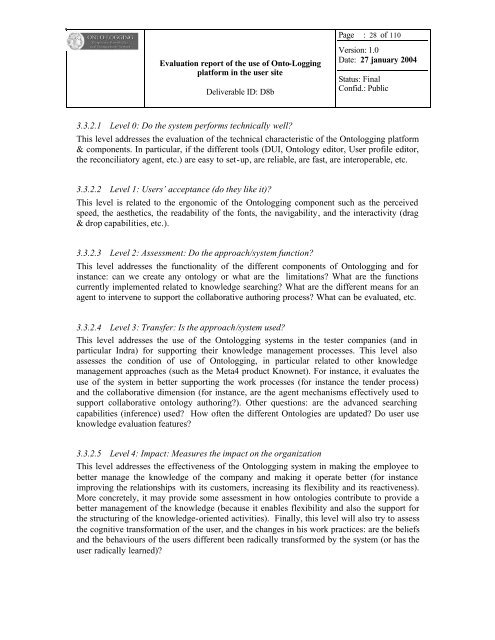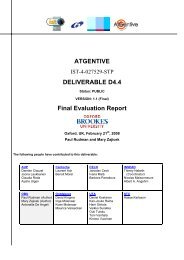pdf 820Kb - INSEAD CALT
pdf 820Kb - INSEAD CALT
pdf 820Kb - INSEAD CALT
Create successful ePaper yourself
Turn your PDF publications into a flip-book with our unique Google optimized e-Paper software.
Evaluation report of the use of Onto-Logging<br />
platform in the user site<br />
Deliverable ID: D8b<br />
3.3.2.1 Level 0: Do the system performs technically well?<br />
Page : 28 of 110<br />
Version: 1.0<br />
Date: 27 january 2004<br />
Status: Final<br />
Confid.: Public<br />
This level addresses the evaluation of the technical characteristic of the Ontologging platform<br />
& components. In particular, if the different tools (DUI, Ontology editor, User profile editor,<br />
the reconciliatory agent, etc.) are easy to set-up, are reliable, are fast, are interoperable, etc.<br />
3.3.2.2 Level 1: Users’ acceptance (do they like it)?<br />
This level is related to the ergonomic of the Ontologging component such as the perceived<br />
speed, the aesthetics, the readability of the fonts, the navigability, and the interactivity (drag<br />
& drop capabilities, etc.).<br />
3.3.2.3 Level 2: Assessment: Do the approach/system function?<br />
This level addresses the functionality of the different components of Ontologging and for<br />
instance: can we create any ontology or what are the limitations? What are the functions<br />
currently implemented related to knowledge searching? What are the different means for an<br />
agent to intervene to support the collaborative authoring process? What can be evaluated, etc.<br />
3.3.2.4 Level 3: Transfer: Is the approach/system used?<br />
This level addresses the use of the Ontologging systems in the tester companies (and in<br />
particular Indra) for supporting their knowledge management processes. This level also<br />
assesses the condition of use of Ontologging, in particular related to other knowledge<br />
management approaches (such as the Meta4 product Knownet). For instance, it evaluates the<br />
use of the system in better supporting the work processes (for instance the tender process)<br />
and the collaborative dimension (for instance, are the agent mechanisms effectively used to<br />
support collaborative ontology authoring?). Other questions: are the advanced searching<br />
capabilities (inference) used? How often the different Ontologies are updated? Do user use<br />
knowledge evaluation features?<br />
3.3.2.5 Level 4: Impact: Measures the impact on the organization<br />
This level addresses the effectiveness of the Ontologging system in making the employee to<br />
better manage the knowledge of the company and making it operate better (for instance<br />
improving the relationships with its customers, increasing its flexibility and its reactiveness).<br />
More concretely, it may provide some assessment in how ontologies contribute to provide a<br />
better management of the knowledge (because it enables flexibility and also the support for<br />
the structuring of the knowledge-oriented activities). Finally, this level will also try to assess<br />
the cognitive transformation of the user, and the changes in his work practices: are the beliefs<br />
and the behaviours of the users different been radically transformed by the system (or has the<br />
user radically learned)?
















